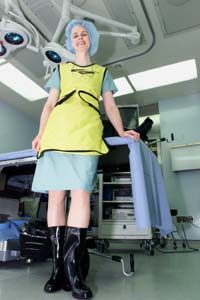
Dr. Elspeth McDougall says the keyhole technique of removing kidneys is less-invasive. (photo by Mary Donaldson)
"Keyhole" technique eases kidney removals
Urologic surgeons at Vanderbilt University Medical Center can now remove kidneys and adrenal glands using the less-invasive "keyhole" technique that has revolutionized other surgeries such as gallbladder removal and appendectomy.
Called laparascopic nephrectomy, the technique offers patients less pain, shorter hospital stays and quicker recuperation.
"There's no question that this is the way to go," said Dr. Elspeth M. McDougall, professor of Urologic Surgery, who joined the faculty last fall. "It is much easier for patients, particularly elderly patients who have heart or other problems, because it puts much less strain on them.
"With traditional surgery, we'll do a large, open incision around the midline of the body or the flank. The incision cuts through major muscles and it can create a lot post-operative discomfort. I know of patients who still complain of some pain years later."
As with other laparascopic surgeries, the new technique uses several incisions less than a half inch long, through which a special telescope and surgical instruments are inserted. The abdomen is inflated with gas to provide room to maneuver, and the surgeon observes what he or she is doing inside the abdomen on a television monitor.
The kidneys are two bean-shaped organs about the size of a large bar of soap whose function is to filter wastes from the blood for excretion from the body in urine. The adrenal glands are pyramid-shaped organs perched atop the kidneys that make hormones.
A number of benign diseases as well as kidney and adrenal cancers may require removal of these organs. Because Vanderbilt is a regional referral center — particularly for the surgical treatment of kidney cancer — surgeons here perform more nephrectomies than other centers in the region.
"It is a challenging surgery because the kidney is a very vascular area, with 12-15 percent of the body's cardiac output moving through every minute," said McDougall, who estimates that she performs two-three nephrectomies each week.
"We have a unique opportunity at Vanderbilt to see these patients, which allows us to develop and maintain expertise with these new techniques," she said.
With techniques such as gallbladder surgery, removal of the hollow organ can be accomplished through the small incisions, but removal of a larger, solid organ like the kidney is more difficult. McDougall came to Vanderbilt from Washington University, where the first laparascopic nephrectomy was performed in 1990.
The kidney is cut away from its connections in the abdominal cavity using the same techniques as open surgery – the only difference is that it is done in a closed procedure with the surgeon observing it on a television monitor. Next, the kidney, which is encased in a fatty compartment, is moved aside. A specially designed, rolled-up bag is inserted in the abdomen through a tube inserted into one of the tiny incisions.
The kidney is slipped into the bag, which is then closed with a drawstring. The opening of the bag is pulled up through the incision so that it can be opened outside the abdomen. The surgeon then inserts into the bag a device called an electric tissue morcellator, which uses blades and suction to cut up and remove the kidney tissue inside the bag.
Once all of the kidney tissue is removed, the bag and the instruments are pulled out and the incisions closed.
With traditional surgery, patients often stay in the hospital three or four days, while those undergoing the laparascopic technique often stay only overnight, she said. In addition, they can return to normal activities sooner, while those who have the large, muscle-cutting incision are prohibited from heavy lifting for four to six weeks. "That can impact how quickly they get back to their job, or may be very debilitating for someone who cares for children or an elderly parent, for example," she said.
As technology continues to improve, McDougall said she expects laparascopy and even less-invasive techniques using radiation and lasers will make open surgery more and more a thing of the past.
"This technique isn't a fad. It's really an improvement in the treatment modality for tumors," she said. "It's really amazing."













